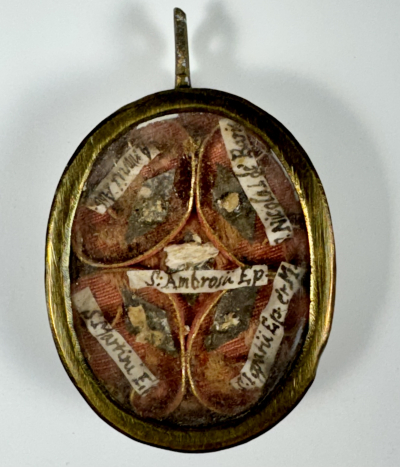Saint Aurelius Ambrosius (†397), better known in English as Ambrose, was a bishop of Milan who became one of the most influential ecclesiastical figures of the 4th century. Ambrose was a staunch opponent of Arianism, and has been accused of fostering persecutions of Arians, Jews, and pagans. Traditionally, Ambrose is credited with promoting "antiphonal chant", a style of chanting in which one side of the choir responds alternately to the other, as well as with composing Veni redemptor gentium, an Advent hymn. Ambrose was one of the four original Doctors of the Church, and is the patron saint of Milan. His feast day is celebrated on December 7 and he is the patron saint of Beekeepers; bees; bishops; candle makers; domestic animals; French Commissariat; geese; learning; livestock; Milan; police officers; students; and wax refiners.
Saint Anthony the Great (†356), was a Christian monk from Egypt, revered since his death as a saint. He is distinguished from other saints named Anthony such as Anthony of Padua, by various epithets: Saint Anthony, Anthony of Egypt, Anthony the Abbot, Anthony of the Desert, Anthony the Anchorite, Anthony the Hermit, and Anthony of Thebes. For his importance among the Desert Fathers and to all later Christian monasticism, he is also known as the Father of All Monks. The biography of Anthony's life by Athanasius of Alexandria helped to spread the concept of Christian monasticism, particularly in Western Europe via its Latin translations. Anthony was among the first known to go into the wilderness (about AD 270), which contributed to his renown. Accounts of Anthony enduring supernatural temptation during his sojourn in the Eastern Desert of Egypt inspired the depiction of his temptations in visual art and literature. Anthony is appealed to against infectious diseases, particularly skin diseases. In the past, many such afflictions, including ergotism, erysipelas, and shingles, were referred to as Saint Anthony's fire. His feast day is celebrated on 17 January among the Orthodox and Catholic churches and on Tobi 22 in the Coptic calendar.
Saint Nicholas († ca. 345) was buried in a church in Myra (modern-day Turkey) and his tomb by the Middle Ages already became a popular place of Christian pilgrimage. In May of 1087, under the pretext of preserving them from the Muslim Turks who occupied Myra, relics of the Saint were stolen by Italian merchants from the place of his burial and transported to Italy where they are still kept in a crypt of a specially built Basilica of St. Nicholas in Bari. According to legend, when Italian merchants opened the sarcophagus, a spicy smell of myrrh spread from the relics of Saint. Merchants from Bari managed to take only some of the relics of the Saint, leaving many smaller fragments in the grave. These fragments were collected by Venetian sailors during the First Crusade (1096-1099) and taken to Venice, where they were kept in the church of St. Nicholas. Modern scientific research in Bari and Venice proved that fragments in two cities belonged to the same skeleton. A small part of the relics is still kept in Turkey in Church of St. Nicholas.
Saint Ignatius of Antioch (†c. 107), also known as Ignatius Theophorus was an early Christian writer and bishop of Antioch. En route to Rome, where he met his martyrdom, Ignatius wrote a series of letters which now form a central part of the later collection known as the Apostolic Fathers and serve as an example of early Christian theology. Important topics they address include ecclesiology, the sacraments, and the role of bishops. In speaking of the authority of the church, he was the first to use the phrase "catholic church" in writing, which is still in use to this day. His feast day was kept in his own Antioch on 17 October, the day on which he is now celebrated in the Catholic Church and generally in western Christianity. In the Eastern Orthodox Church it is observed on 20 December.
Saint Martin of Tours (†397) was the third bishop of Tours. A native of Pannonia (present-day Hungary), he converted to Christianity at a young age. He served in the Roman cavalry in Gaul, but left military service prior to 361, when he became a disciple of Hilary of Poitiers, establishing the monastery at Ligugé. He was consecrated as Bishop of Caesarodunum (Tours) in 371. He is best known for the account of his using his sword to cut his cloak in two, to give half to a beggar clad only in rags in winter. His shrine in Tours became an often-frequented stop for pilgrims on the road to Santiago de Compostela in Spain. He is the patron saint of many communities and organizations across Europe, including France's Third Republic. His feast day is commemorated on 11 November by the Catholic Church and on 12 November by the Eastern Orthodox Church.









 Поменять язык на русский
Поменять язык на русский 